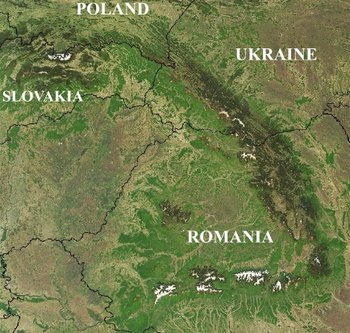Carpathian Mountains
|
|
- This is about the terrestrial mountain range. There is also a lunar range called the Montes Carpatus.
The Carpathian Mountains (Hungarian Kárpátok; Romanian Carpaţi; Ukrainian Карпати; Polish, Czech , and Slovak Karpaty) are the eastern wing of the great Central Mountain System of Europe, curving 1500 km (~900 miles) along the borders of the Czech Republic, Slovakia, Poland, Romania, and the Ukraine.
Name
The name is most likely derived from the Carp, a Dacian tribe, attested in Late Roman Empire documents (Zosimus) until 381 as living on the Eastern Carpathian slopes. Alternately, the name of the tribe may have been derived from the name of the mountains. The name 'Karpetes' may ultimately be from the Indo-European root *sker/*ker, from which comes the Albanian word 'karpë' (rock), perhaps by way of a Dacian word which meant 'mountain', 'rock', or 'rugged'.
In late Roman documents, the Eastern Carpathian Mountains were reffered to as Montes Sarmatici. The Western Carpathians were called Carpates. The name Carpates is first recorded in Ptolemy's Geography.
In the scandinavian Hervarar saga, which describes ancient Germanic legends about battles between Goths and Huns, the name Karpates appears in the predictable Germanic form Harvaða fjöllum (see Grimm's law).
In official Hungarian documents of the 13th and 14th centuries, the Carpathians are named Thorchal or Tarczal, or the latinate Montes Nivium.
Geography
The Carpathians begin on the Danube near Bratislava. They surround Transcarpathia and Transylvania in a large semicircle, sweeping towards the south-west, and end on the Danube near Orşova, in Romania. The total length of the Carpathians is over 1500 km. the mountain chain's width varies between 12 and 500 km. The greatest width of the Carpathians corresponds with its highest altitudes. Thus the system attains its greatest breadth in the Transylvanian plateau, and in the meridian of the Tatra group (the highest range, with Gerlachovský štít, at 2655 m (8705 ft.) above sea level- in Slovakian territory). It covers an area of 190 000 sq. km, and, after the Alps, is the most extensive mountain system in Europe.
Although commonly reffered to as a mountain cain, the Carpathians do not actually form an uninterrupted chain of mountains. rather, they consist of several orographically and geologically distinctive groups, presenting as great a structural variety as the Alps. The Carpathians, which only in a few places attain an altitude of over 2500 m, lack the bold peaks, extensive snow-fields, large glaciers, high waterfalls and the numerous large lakes which are common in the Alps. No area of the Carpathian Range is covered in snow year-round, and there are no glaciers. The Carpathians at their highest altitude are only as high as the Middle Region of the Alps, with which they share a common appearance, climate, and flora.
The Carpathians are separated from the Alps by the Danube. The two ranges meet only in two points; the Leitha Mountains, at Bratislava, and the Bakony Mountains. The river also separates them from the Stara Planina, or "Balkan Mountains", at Orsova, Romania. The valley of the March and Oder separates the Carpathians from the Silesian and Moravian chains, which belong to the middle wing of the great Central Mountain System of Europe. Unlike the other wings of the system, the Carpathians, which form the watershed between the northern seas and the Black Sea, are surrounded on all sides by plains, namely the Pannonian plain on the south-west, the plain of the Lower Danube (Romania) on the south, and the Galician plain on the north-east.bg:Карпати de:Karpaten es:Montes Cárpatos ja:カルパティア山脈 nl:Karpaten pl:Karpaty pt:Cárpatos ro:Munţii Carpaţi sv:Karpaterna uk:Карпати

